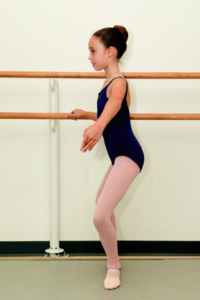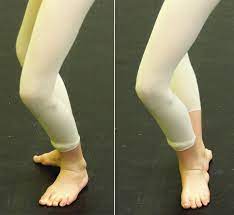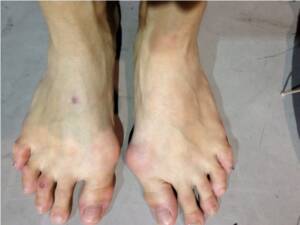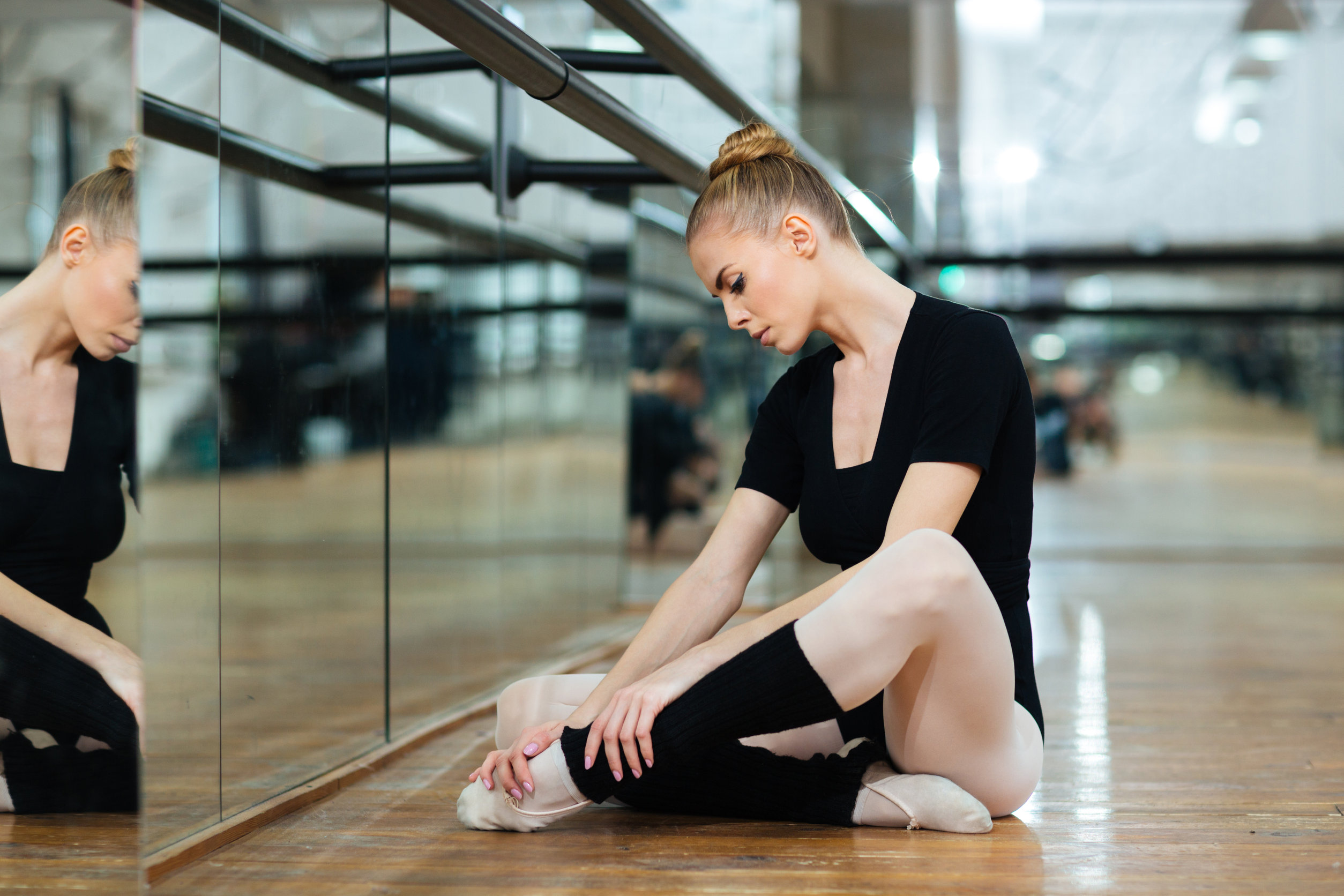Cómo Somática Clínica Previene lesiones y mejora el entrenamiento de los bailarines de ballet
Ballet dancers make their movements look effortless, but in reality, ballet is just as physically, mentally, and psychologically demanding as American football. It takes thousands of hours of rigorous training to develop the strength, stamina, finely-tuned muscular control and artistry necessary to perform ballet at a professional level.
One of the aspects of ballet that makes it so challenging is turnout. Ballet dancers must perform all of their movements with their legs turned out from the hips, so that their toes point outward. Turnout creates the graceful, aesthetically pleasing lines of ballet movements and the streamlined, sculpted muscles of the dancers’ bodies.
Desafortunadamente, dado que evolucionamos para movernos con las piernas en paralelo y los dedos de los pies apuntando hacia adelante, obligar al cuerpo a moverse con las caderas hacia afuera puede provocar tensión muscular crónica, dolor y lesiones recurrentes. Nuestros músculos y esqueleto simplemente no están diseñados de forma natural para moverse mientras se mantienen posiciones abiertas. Somos capaces de hacerlo porque la articulación de la cadera es una articulación esférica que permite una rotación externa (lateral) sustancial; pero se necesita un entrenamiento extenso para desarrollar el tipo específico de fuerza y control muscular necesarios para mantener las caderas hacia afuera mientras se extienden las piernas de manera segura, balanceándose, saltando y girando.
On top of the physical problems that can result from turnout, dancers are all individuals with unique patterns of muscle tension that they develop outside of the studio. Stress, daily habits, injuries, other types of physical training, and even personality can cause dancers to adopt poor posture or imbalances in their muscle tension and alignment that can affect their dance technique.
Otro aspecto del ballet (y otras prácticas físicas artísticas como la gimnasia y el patinaje sobre hielo) que genera problemas físicos es el hecho de que los bailarines deben lograr posiciones y movimientos desde un punto de vista estético. Esto hace que los bailarines fuercen su cuerpo en ciertas posiciones y se muevan a través de movimientos que su cuerpo no es capaz de hacer correctamente. Forzar y mover los músculos conduce a una alineación incorrecta y la acumulación de tensión muscular excesiva. Los bailarines solo pueden salirse con la suya durante un tiempo antes de que su cuerpo comience a descomponerse con lesiones recurrentes, como lo experimenté de primera mano cuando era bailarina de ballet.
Para prevenir lesiones y alargar la vida de los bailarines, se debe enseñar a los bailarines jóvenes desde una edad temprana a 1) entrenar gradualmente su alineación y movimiento correctamente en lugar de forzarse a adoptar posiciones para las que sus músculos no han sido entrenados adecuadamente. todavía, y 2) dan la misma importancia a su sentido interno de cómo están usando sus cuerpos y lo que ven en el espejo.
Patrones comunes de tensión y lesiones en bailarines
Lower back pain and injuries: When dancers aren’t able to attain full turnout from their hips, they typically tip their pelvis forward in order to gain more external hip rotation. This results in an arched lower back. Over time, the lower back muscles become extremely tight and prone to spasm, and the lumbar vertebrae, discs, and potentially the sciatic nerve are compressed.
Chronic tightness in gluteal muscles: The gluteal muscles are external hip rotators, so ballet dancers use their glutes all the time to help them stay turned out. The glutes are also powerful muscles used in jumping. Chronic muscle tension in the gluteal muscles can lead to piriformis syndrome and limited hip mobility.
Knee and ankle pain and injuries: If a dancer is not able to attain full turnout from their hips, they will often force their toes to point outward and end up rolling inward at their knee and ankle joints. This puts a great deal of strain on the knees and ankles, and can lead to chronic pain, tendon and ligament injuries, and wearing away of cartilage.
Bunions: A bunion is a bony, often painful bump that forms on the joint at the base of the big toe. Ballet dancers may develop bunions due to forcing their turnout and rolling inward on their feet (pronation), which puts a great deal of pressure on the big toe joint. Female ballet dancers may also develop bunions from dancing en pointe, which puts the weight of the entire body on the toes.



Juanetes
Psoas syndrome: The psoas major is a deep core muscle that is used extensively in dance. The psoas helps to externally rotate the hips, flex the hips (lifting up the legs), adduct the hips (bring the legs in toward each other), and laterally flex the spine (bending the spine to either side). The psoas often becomes chronically tight in ballet dancers, causing hip and lower back pain, postural imbalances, and internal snapping hip syndrome.
Shin splints and stress fractures: Jumping and pointework, especially when practiced excessively or on hard or un-sprung flooring, can lead to shin splints developing in the tibia and stress fractures developing anywhere in the lower leg, ankle, or foot. Once a stress fracture has developed, dancers must be extremely careful to let it heal so that they do not fully break the bone.
Achilles tendinitis and plantar fasciitis: Dancers are constantly pointing their feet, which contracts the calf muscles and muscles on the bottom of the feet, and shortens the Achilles tendon. As a result, the painful conditions of Achilles tendinitis and plantar fasciitis are common among dancers. Rupture of the Achilles tendon can also occur if sudden strain is put on an Achilles tendon that is already short and tight.
Muscle strains: Dancers are prone to muscle strains because they can develop a great deal of tension in their muscles. Suddenly stretching a tight muscle during a leg extension or a jump can easily result in a muscle strain, which can take anywhere from a few days to several months to fully heal depending on the severity of the strain.
Cómo la pandiculación puede transformar su entrenamiento de danza
Dancers begin developing learned muscular patterns—aka muscle memory—as soon as they begin their dance training. Deeply learned muscular patterns are necessary in order for dancers to move quickly and effortlessly. But if young dancers aren’t trained correctly, or if they increase the difficulty or intensity of their training too quickly, they can easily develop compensatory muscular patterns that become damaging to their body over time.
Cuanto más repetimos una postura o un movimiento, más profundamente lo aprende nuestro sistema nervioso. A medida que aplicamos un patrón muscular a nuestra memoria muscular, los músculos involucrados en ese patrón tienden a acumular más y más tensión crónica. Por ejemplo, cuanto más a menudo inclinemos la pelvis hacia adelante y arqueemos la zona lumbar, más tensos estarán los músculos lumbares.
Así como se entrena inicialmente la memoria muscular, se puede volver a entrenar. Por lo tanto, los bailarines no se quedan atrapados con sus patrones musculares dañinos de por vida. Desafortunadamente, la mayoría de los bailarines no saben cómo reducir el nivel de tensión en sus músculos para poder reentrenar eficazmente su memoria muscular. A los bailarines se les enseña a estirar, estirar y estirar un poco más para alargar sus músculos, pero el efecto del estiramiento en la longitud de los músculos es temporal y no permite el reentrenamiento de la memoria muscular. El estiramiento también tiende a alargar los tendones y ligamentos, lo que genera articulaciones inestables y da la ilusión de flexibilidad.
If you want to learn more about why stretching doesn’t work:
Watch Why Stretching Doesn’t Work
Read What is the Stretch Reflex (Myotatic Reflex)?
Read Why Stretching Doesn’t Work
Read El Secreto del Alivio del Dolor
Pandiculation is the nervous system’s natural way of releasing built-up muscle tension, and it is far more effective than static stretching. Pandiculation involves gently contracting a muscle or muscle group, then releasing extremely slowly against gravity or resistance provided by a practitioner. The extremely slow release against resistance sends accurate biofeedback to the nervous system about how much tension is being held in the muscle. As a result, the gamma loop (a feedback loop in the nervous system that regulates the level of tension in muscles) is reset, and the baseline level of tension in the muscles being pandiculated is reduced.
Como ex bailarina que sufrió lesiones recurrentes y fue adicta a los estiramientos durante muchos años, puedo decirles que mi vida cambió cuando detuve los estiramientos estáticos y comencé a pandicular mis músculos. Mis músculos se sentían realmente relajados, una sensación muy diferente a la que había tenido después de estirarme, y me sentí completamente cómodo en mi cuerpo por primera vez que podía recordar. Solo puedo imaginar que podría haber seguido bailando durante muchos años más si hubiera descubierto Somática Clínica a una edad más temprana.
Pandiculation releases the chronic tension in muscles that has built up due to overuse. As the chronically tight muscles relax and lengthen, dancers are freed from the prison of their deeply learned muscular patterns, and become able to retrain their bodies to move correctly and safely.
Somática Clínica Los ejercicios también desarrollan un control muscular y la propiocepción (sentido interno de la posición del cuerpo) finamente afinados, de modo que los bailarines pueden sentir cuándo su postura o movimiento se desvían un poco y corregirlo antes de que se produzca algún daño.
En un mundo ideal, a los bailarines se les enseñaría Somática Clínica ejercicios a una edad temprana, y los practicaría como su rutina diaria de cuidado personal en lugar de estiramientos estáticos. Esto les permitiría aprender la técnica del ballet de forma segura y correcta, sin desarrollar patrones compensatorios dañinos, y les daría la conciencia sensorial para evitar lesiones a medida que envejecen.
Si eres un bailarín adolescente o adulto y tienes músculos tensos crónicos, dolor o lesiones recurrentes que están afectando tu entrenamiento o carrera, puedes incorporar Somática Clínica ejercicios en su rutina diaria para liberar su tensión muscular crónica, aliviar su dolor y prevenir lesiones futuras. Puede utilizar los ejercicios para liberar suavemente los músculos tensos de todo el cuerpo. Una vez que comiences a practicar los ejercicios a diario y sientas los efectos que tienen en tu cuerpo, ¡te preguntarás cómo has bailado sin ellos!
You can learn Clinical Somatics exercises in the online Level One & Two Courses. The courses teach 40 exercises for the entire body, one-by-one through video demonstrations, audio classes, and written notes. By the end of the courses you’ll be self-sufficient, able to lie down and practice the exercises that your body needs each day.
Lectura recomendada:
The Pain Relief Secret: How to Retrain Your Nervous System, Heal Your Body, and Overcome Chronic Pain by Sarah Warren, CSE
Somatics: Reawakening the Mind’s Control of Movement, Flexibility and Health by Thomas Hanna



